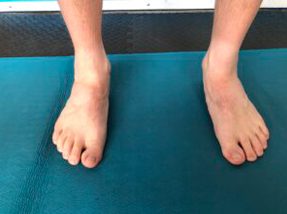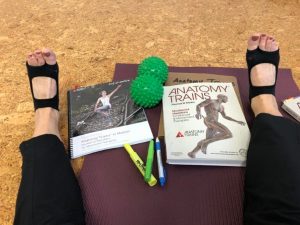Corrective Exercises
Example of overpronation of feet to the right. – Overpronation is when the foot rolls inward toward the arch excessively and can cause various misalignments of the joints moving up the linear chain, putting the body at increased risk of developing specific injuries. Overpronation is common in those who have developed Plantar Fasciitis.


Here are two examples of corrective exercises to help regain strength in the arches of the feet (helping to avoid collapse into “flat feet”) and re-set the correct alignment of the ankle joint. This correction additionally helps re-align and re-set the knee and hip joints to a more neutral position.
Over the past several decades there has been an epidemic rise in the number of people suffering from common musculoskeletal imbalances that are not caused by an injury. These imbalances are caused by other factors, such as movement dysfunction, activity choices, prolonged static postures, footwear choices, surgeries and sedentary lifestyles. Many of these people with common musculoskeletal imbalances do not need physical therapy, and so the field of corrective exercise is evolving to fill the gap in care for this population. As a result, the use of musculoskeletal assessments, self-myofascial release, restorative stretching, and corrective strengthening exercises in health and fitness settings is fast becoming commonplace.
As a Corrective Exercise Specialist my skill set is focused on addressing the body as a whole and identifying underlying causes of a clients chronic pain not just the symptoms and help prevent the body from breaking down in the future. Using a sequenced method of Corrective Exercise and Fascial Release techniques the benefits of this training can result in not only the elimination of pain, but lead to a reduction in stress and improvement in active performance and functional daily living.
The Corrective Exercise method is for the many active-aging individuals who wish to train without pain, for individuals who would like to bridge the gap between (pre-hab/re-hab) physical therapy and fitness and for those who have compensatory movement from structural malalignments that they want to correct and functionally move without discomfort.

FASCIA FITNESS
Muscles and fascia always work together. Fascia fitness training incorporates sequenced movements on and off a soft foam roller along with stretching focusing on hydration of the connective tissue making it more pliable and less “sticky”. Additionally, the use of Trigger point balls for adhesion point release to help reduce discomfort and pain while increasing joint mobility.


Med note: Functional fitness involves more than simply performing many reps of a single joint bicep curl. That’s because exercises that isolate joints and muscles are training muscles which results in less functionalimprovement. Functional movement training enhances the coordinated working relationship between your nervous and muscular systems. For example, squats will have a greater transfer effect on improving an individual’s ability to rise from the seat of a car or a couch than a seated single joint knee extensions on a leg extension machine.